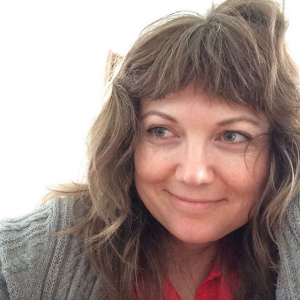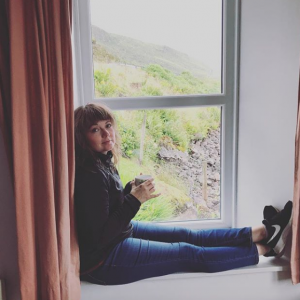November 10, 2018 • Open Account
In Open Account, Hannah Stephenson profiles artists, sharing their financial and creative memories, successes, and challenges. First up: Amanda Page.
Amanda Page, Reliable Narrator
 Memory, home, place, finance, wellness, education. Essays, blog posts, articles, workshops, lectures, and live storytelling. Amanda Page has explored many subjects and genres, and her current work as a writer, oral storyteller, and editor/coach weaves these threads together organically. A self-described “teller and shaper of true stories,” Page’s voice is unflinchingly honest, approachable, and insightful.
Memory, home, place, finance, wellness, education. Essays, blog posts, articles, workshops, lectures, and live storytelling. Amanda Page has explored many subjects and genres, and her current work as a writer, oral storyteller, and editor/coach weaves these threads together organically. A self-described “teller and shaper of true stories,” Page’s voice is unflinchingly honest, approachable, and insightful.
With a background in creative writing, Page previously wrote essays about the environment, historical buildings, and place. In 2013, she found herself in what she calls “a perfect storm of life change,” including a divorce, job change, and move. She also had $48,000 of student loan debt that she’d carried with her for a decade. “My past had informed my mindset that kept me in debt, and in 2013, I declared bankruptcy. I was seeking relief—I felt so buried,” she shared candidly. After removing some of this pressure through bankruptcy, Page focused on learning about money and building sustainable habits. A turning point for her was discovering Barbara Stanny’s book, Overcoming Underearning, and working through its exercises with a friend.
The following year, an overwhelming amount of opportunities beckoned. “I was interviewing for many jobs, freelancing, deciding if I was going to move out of state for a master’s program,” she explained. “And then I took an online job teaching writing, and it paid well enough that I was able to open an IRA, which was the very first time I could think of retirement. This sparked an idea—what if I could make enough money to pay off this student loan debt, $48,000, in a year?”
Reader, she did.
While completing this Herculean task, her writing necessarily expanded to include finance, and her blog was born. In writing about money, Page’s writing garnered media attention from outlets like CNBC and Huffington Post, and resonated with new audiences—those focused not only on finance, but also on personal growth. She is also connecting with audiences in-person, by telling stories onstage and holding workshops to help others harness their own narratives. We spoke about her evolving creative work, and the role that finance plays for her today.
On how finance fits in with her creative work
“The finance community is often about personal development. I’ve learned to finish things, come through for myself. One of the old stories I had about myself was that I never followed through. But once I paid off that debt, it gave me a whole new story about myself and how I could focus on something. And gave me a new creative life in that way.”
On her early money memories
“At 10 years old, I stepped out of the car, and found a $20 bill. I picked it up and showed my mom—-we went into the house, and all of my family members exclaimed, ‘Oh my God!’ Everyone had an opinion about what I should do with it. I stood there with that $20 bill in my hand, watching the adults in my life argue about what I should do with the money (save it, spend it, and how). This created a weird bubble around money for me…I remember wanting to please everyone with what I’d do. I hit everyone’s desires by putting it in a savings account, and then withdrawing it and spending it. It was an exercise in futility.”
“I grew up in a low income area, but my parents earned stable, lower middle class incomes. I remember being at a friend’s house, waiting to be picked up by my parents. My mom pulled up in our new car (a red Ford, very practical), and my friend’s mom said, ‘What bank did your family rob?’ I was probably 15, and recognized it was an insult. But what struck me later—she called my mom and asked her how we afforded it. My mom then taught her how to use credit. This showed up later in my life when I was 22, in college, and wanted to backpack around Europe. My mom taught me how to use credit to do this. My mom and dad had learned how to work their way up. My mom had taken out student loans, and was the first in the family to get a college degree.”
On paying off her student loan debt and writing about it
“This was a total experiment. I lived with the question, what if this were possible? I’d been told, ‘Start, and the how will happen.’ I just walked into it trusting the experiment. I focused on putting together big payments, making more money, and also keeping my living and transportation costs low (through living with a roommate and driving an older, paid off car).”
“[My personal finance project and blog] felt so outside the realm of my creative work. But what I noticed about my creative work during that time was that while I watched the debt go down, the interest in my creative work was going up. I was now thinking of what was possible in my own writing and creative work. I was constantly asking for things, putting myself out there. I applied to be a sign dancer at a tax place. I applied to sell furniture. I applied for ANY opportunity that was mildly interesting. I also applied for a creative artist grant, and got that. The more you put yourself out there, the more becomes possible.”
On teaching others and future goals
“I am interested in becoming financially independent as a way to preserve my own creative time. I’m pursuing this gradually. I just worked with a coach to figure out how all of this—frugality, independence, arts advocacy, travel—fits together. She had me send out a survey through social media, and the results were interesting. The number one thing people wanted to hear about from me was storytelling, and the last was debt-free living. Personal finance writers need help with story and writing, too. I’m now offering services for how to monetize your creative life. Your life is made up of all of these little stories—be sure you’re telling the right ones to yourself and others.”
Amanda’s Tips
 “Take an inventory of the tools at your disposal. List every one of your resources—car, business attire, contacts, old bosses. Truly exhaust your list. Doing this made me realize how much I had to work with! It’s an evergreen exercise. I just did it a couple weeks ago for my next project (organizing writers’ retreats). It’s a good tool for different phases of life and work.”
“Take an inventory of the tools at your disposal. List every one of your resources—car, business attire, contacts, old bosses. Truly exhaust your list. Doing this made me realize how much I had to work with! It’s an evergreen exercise. I just did it a couple weeks ago for my next project (organizing writers’ retreats). It’s a good tool for different phases of life and work.”
“I love the free money app mint.com. I look at my balance every day. Even when it’s low. No matter what, I would look at it and practice feeling gratitude for what I saw. I discovered during that journey [of loan payoff] that gratitude could conjure magic in your life. It was a signal saying, ‘Hey, look, I’m paying attention to this.’ What you’re focusing on grows.”
Know someone we should feature in an Open Account profile? Email [email protected] with the subject line “Open Account.”


